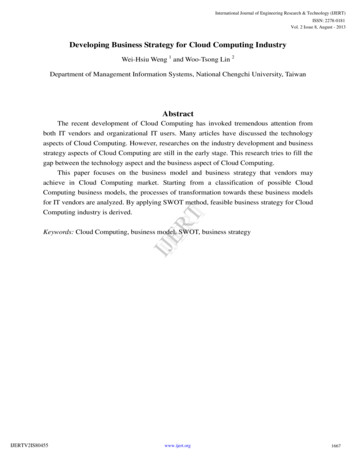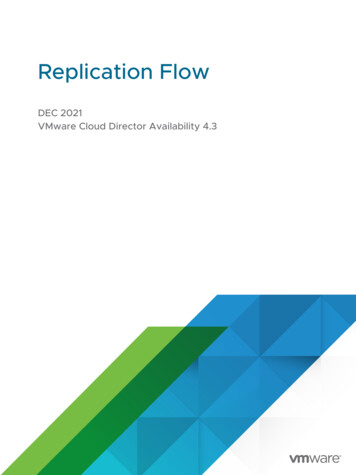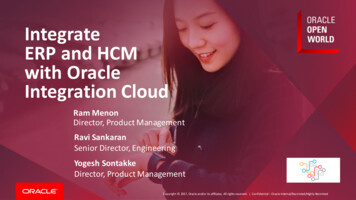
Transcription
International Journal of Engineering Research & Technology (IJERT)ISSN: 2278-0181Vol. 2 Issue 8, August - 2013Developing Business Strategy for Cloud Computing IndustryWei-Hsiu Weng 1 and Woo-Tsong Lin 2Department of Management Information Systems, National Chengchi University, TaiwanAbstractThe recent development of Cloud Computing has invoked tremendous attention fromboth IT vendors and organizational IT users. Many articles have discussed the technologyaspects of Cloud Computing. However, researches on the industry development and businessstrategy aspects of Cloud Computing are still in the early stage. This research tries to fill thegap between the technology aspect and the business aspect of Cloud Computing.This paper focuses on the business model and business strategy that vendors mayachieve in Cloud Computing market. Starting from a classification of possible CloudComputing business models, the processes of transformation towards these business modelsIJERTfor IT vendors are analyzed. By applying SWOT method, feasible business strategy for CloudComputing industry is derived.Keywords: Cloud Computing, business model, SWOT, business strategyIJERTV2IS80455www.ijert.org1667
International Journal of Engineering Research & Technology (IJERT)ISSN: 2278-0181Vol. 2 Issue 8, August - 20131. IntroductionThe Cloud Computing concept has made a major impact on the products, services andbusiness models of the IT software and hardware industries. Cloud computing has thereforebecome the emerging concept and technology that has drawn the most attention from the ITsoftware and hardware industries in the period of the 2008 global financial crisis. The sheerscope of the industry as well as the fact that it spans both the enterprise and consumermarkets has led to much discussion on its future business potential as well. Nevertheless,Cloud Computing technologies and business models as well as the new products, services,competition and alliances that arise as a result offer an emerging market that is well worthmonitoring.Currently, major IT firms are exploiting possible business opportunity into CloudComputing market. The Taiwanese IT vendors are strong players worldwide in themanufacturing and integration of IT devices and services. To assist the Taiwanese IT vendorsmoving forward towards the emerging Cloud Computing market, this research aims toaddress the question of deriving possible market strategies for the Taiwanese CloudComputing industry.IJERT2. Literature Review2.1 Cloud Computing TechnologyArmbrust et al. (2009) presents a comprehensive discussion on the characteristics ofCloud Computing. The advantages of adopting Cloud Computing include cost down, full useof the limited computing and storage resources, and scalable commercial computing datacenter. Cloud Computing users are relieved of dealing with over-provisioning andunder-provisioning of computing resources from their internal data centers. Buyya1 et al.(2008) indicates that cloud computing is a new and promising paradigm delivering ITservices as computing utilities. They proposed architecture for market-oriented allocation ofresources within clouds and discussed some representative platforms for cloud computing.Keahey and Freeman (2008) summarizes early experiences with the Science Cloud test bed,and describes configuration and tools that were used to configure the Science Clouds. Theypresent information about how the clouds were used and what usage patterns were observed.Katzan (2009) points out the issues of transferring large amounts of data into and out ofclouds, with particular emphasis on data protection. Vouk (2008) and Foster et al. (2008) alsodiscuss the implementation issues of cloud computing services. Since Cloud Computingintegrates various virtual resources, how to effectively manage large scale of infrastructure isa primary issue for vendors (Sotomayor et al., 2008). Many other research articles also havediscussed the technology development of Cloud Computing. However, the industry andbusiness aspect of Cloud Computing has not been widely discussed in the literature so far.IJERTV2IS80455www.ijert.org1668
International Journal of Engineering Research & Technology (IJERT)ISSN: 2278-0181Vol. 2 Issue 8, August - 20132.2 Business ModelThe business model concept is becoming increasingly popular within MIS, managementand strategy literature. It is used within many fields of research, including both traditionalstrategy theory and in the emergent body of literature on e-business.Business model is a term often used to describe the key components of a given business.It is particularly popular among e-businesses and within research on e-businesses (Afuah andTucci, 2001).Despite of its importance, no generally accepted definition of the term ‘‘business model’’has emerged. Diversity in the available definitions poses substantive challenges for delimitingthe nature and components of a model and determining what constitutes a good model. It alsoleads to confusion in terminology, as business model, strategy, business concept, revenuemodel, and economic model are often used interchangeably. Moreover, the business modelhas been referred to as architecture, design, pattern, plan, method, assumption, and statement(Morris et al., 2003).IJERT2.3 SWOT and Business StrategyThe SWOT analysis is an established method for assisting the formulation of strategy.SWOT analysis aims to identify the strengths and weaknesses of an organization and theopportunities and threats in the environment. Having identified these factors strategies aredeveloped which may build on the strengths, eliminate the weaknesses, exploit theopportunities or counter the threats. The strengths and weaknesses are identified by aninternal appraisal of the organization and the opportunities and threats by an externalappraisal (Dyson, 2004).A variation of SWOT analysis is the TOWS matrix (Weihrich, 1982). In the TOWSmatrix the various factors are identified and these are then paired, for example, anopportunity with a strength, with the intention of stimulating a new strategic initiative.The four combinations in the TOWS matrix, which are matching pairs of specificinternal and external factors, are called the Maxi-Maxi (Strengths/Opportunities, SO),Maxi-Mini (Strengths/Threats, ST), Mini-Maxi (Weakness/Opportunities, WO), andMini-Mini (Weaknesses/Threats, WT).3. Research MethodSince many emerging technologies are still in the development phase, this study willemploy qualitative methods. Qualitative data analysis are employed instead of quantitativedata analysis, by way of expert panel and vendor interviews.The methods are appropriate in this study because there is an insufficiency ofwell-established models for business strategy in Cloud Computing industry. These methodsIJERTV2IS80455www.ijert.org1669
International Journal of Engineering Research & Technology (IJERT)ISSN: 2278-0181Vol. 2 Issue 8, August - 2013aim at distilling and structuring opinions from the participants until a consensus or pattern isformed (Smaling, 2003; Vicsek, 2007).3.1 The Expert PanelThe purpose of this investigation into Cloud Computing market strategy was to qualify,rather than quantify, and therefore the study adopted a panel group approach. The expertpanel from the industry is to assist the convergence process of data analysis. To this objective,industrial experts panel of eleven people were selected. The panel consists of CEO, CIO andline of business managers from various domains of Taiwanese IT industry. All of them arefrom publicly listed firms. Their business domains include System Integration(SI),Independent Software Vendor (ISV), Internet Service Provider(ISV), device manufacturer,and data center operator. These are the major participants in the Cloud Computing industry.The main function of the Expert Panel is to help determining the research framework andderiving strategy. In particular, the following questions are discussed.1. What are the possible Cloud Computing business models within the context of theTaiwanese IT industry and environment?IJERT2. With regards to these business models, what is the process of transformation towardsCloud Computing for the Taiwanese IT industry?3. Within this transformation process, what are the business environments in terms ofinternal strengths and weaknesses, as well as external opportunities and threats of the ITfirms?4. Recognizing the internal and external business environments, what are the possiblebusiness strategies that could be developed for the IT industry?3.2 The Vendor InterviewsRepresentative IT firms from Taiwan are selected as the objects of study. The selectionprocess is based on the rank of the revenue of the firms as well as their reputation in terms oftechnology innovation and market visibility. IT vendors of Taiwan enjoy high market shareworldwide in the sectors such as computer, communication and consumer electronicsmanufacturing. Currently the Taiwanese vendors participate in Cloud Computing include ITdevice manufacturers, IT service providers, and Internet datacenter operators. We collect andanalyze business proposal data of 35 Taiwanese IT vendors in cloud computing.The selection criteria are as follows.1. Revenue of the firm is among the top five in its industry domain.2. The firm has announced in public its vision, strategy, products or service towardCloud Computing market.Based on these criteria, 30 IT firms are selected and summarized in the following table.IJERTV2IS80455www.ijert.org1670
International Journal of Engineering Research & Technology (IJERT)ISSN: 2278-0181Vol. 2 Issue 8, August - 2013Table 1: Selected CasesBusiness DomainNumber of FirmsIndependent Software Vendor (ISV)6System Integration Provider (SI)8Telecom Operator3Server and storage device manufacture5Networking device manufacture3Mobile device manufacture5Total303.3 The Research ProcessThe research process is depicted in Figure 1 below. On site interviews with the businessmanagers of vendors listed in Table 1 are conducted. These interviews are for collecting theup to date development trends of the Cloud Computing industry, including the transformationFigure 1. Research ProcessTraditional ITBusiness ModelIJERTprocess towards Cloud Computing, the possible opportunities and potential threats of theindustry. These findings serve as the base data for the following phase of SWOT analysis.Cloud ComputingBusiness ModelTransformationProcessCloud ComputingBusiness StrategySWOT and TOWSAnalysis4. Data Analysis and Results4.1 Cloud Computing Business ModelSeveral researches have proposed frameworks to identify business models. Morris et al.(2003) proposed a set of six questions for defining basic components of business models. Inthe context of Cloud Computing, Rappa (2004) described a framework to classify businessmodels using the customer relationship as the primary dimension for defining categories.This has proven to be a useful framework because it builds upon a common parlance alreadyused in many industries to describe methods of business. Using this approach, nine majorcategories are used to classify a number of different types of business models that have beenidentified in practice among Web-based enterprises and also Utility Computing firms.IJERTV2IS80455www.ijert.org1671
International Journal of Engineering Research & Technology (IJERT)ISSN: 2278-0181Vol. 2 Issue 8, August - 2013By using a classification approach similar to that of Rappa (2004), business models ofCloud Computing are identified and summarized in Table 2.IJERTTable 2. Cloud Computing Business ModelsBusiness ModelDescriptionEntry into the cloud supplychain through smartphones,Cloud communicationtablet, netbook PC, networkand mobile devicecommunication equipment,and other products.Entry into the cloud supplychain through servers, storageCloud server andequipment, power suppliers,storage equipmentand other branded products ofOEM operations.Provision of broadbandCloud service and data service, data center services,centerand various XaaS servicesneeded in cloud computing.Assistance offered to cloudservice and mobile deviceCloud software andsetup through systemserviceintegration, softwaredevelopment, consultancyservices, and other operations.Taiwanese Vendor ExamplesHTC, Asus, Acer, D-Link,GemtekQuanta, Inventec, Gigabyte,Delta Electronics, Infortrend,PromiseChunghwa Telecom, TaiwanFixed Network, FETnet, AcereDC, ASUS webstorage, GSSSystex, DataSystems, theSyscom Group, FortuneInformation Sysetms Corp.,Tatung System TechnologiesInc., Genesis Technology, Inc.,Stark Technology Inc.4.2 Transformation towards Cloud Computing Business Models4.2.1 Transformation towards Cloud Software and ServiceWith the gradual heating of the cloud computing market, Taiwan’s IT services andsoftware industry in 2011 put forward the relevant cloud computing products and services tograsp the IT business of the existing customer groups, pack existing technology or products,convert and upgrade to the new cloud computing model software and services, develop theprivate cloud market, and cooperate with data center industry to cut into the realm of publiccloud services and diversified development.On the aspect of private cloud market development and management, systemsintegration was conducted, and consultancy services manufacturers engaged to proceed withimport services of the cloud server and virtualization products and cooperate with foreignfirms such as IBM, HP, EMC/VMWare, and so on. Then using proprietary software andplatforms, software developers began conducting the publication of SaaS services andcooperating with telecommunication operators in China, Japan, and other markets to expandtheir overseas market.IJERTV2IS80455www.ijert.org1672
International Journal of Engineering Research & Technology (IJERT)ISSN: 2278-0181Vol. 2 Issue 8, August - 20134.2.2 Transformation towards Cloud services and Data CenterThe infrastructure provider industry of the public cloud services is the cloud data centerservices. Taiwan has the advantages of safety and stability, low cost water and electricity, andgood basic conditions. Using the hardware and software facilities to develop differentiatedand niche public cloud services can create opportunities for enterprises in the rush for thecloud.With the development of public cloud services, information security has attracted extraattention. Cloud services and data center industry work to strengthen the security mechanismor cooperate with leading information security companies to reduce users’ worry. Thus,enhancing the cloud data protection remains the key to market development. In addition, thecloud data center is also gradually transforming and upgrading to become the IT SecurityOperation Center (SOC) and is cooperating with the mobile device operators and the softwaredevelopment industry to develop the mobile application software marketplace so that itcombines the market developments of the public cloud and the smart mobile devices. Theimpact of the recent 311 earthquake in Japan has made remote backup a serious issue, anddisaster recovery and data backup programs are also value-added services that the industryhas actively developed.IJERT4.2.3 Transformation towards Cloud Servers and Storage EquipmentTaiwan maintains an important world position in the IT communication hardwareequipment manufacturing industry and has the advantage of the high logistics flexibility inthe global information and communications equipment manufacturing supply chain. Theweak economy of the U.S. and European market in recent years, coupled with frequentnatural disasters, unstable supply of raw materials, and highly competitive industry hasresulted in the decline of manufacturers’ gross profit. With the rise of the cloud computingmarket, large data centers have been built to meet the demands of server and storageequipment and the cumulative fast-growth of enterprise data year by year. The inevitabletrend of the expansion of data storage capacity of the enterprise is a market opportunity forthe IT equipment industry. How to conduct market transformation in response to the cloudcomputing trend will be a major challenge facing the industry.Taiwan’s IT communication industry has abundant experience in OEM and a completesupply chain. It has had a solid basis in the market of overall cloud computing informationand communications equipment, but with the progress of the public cloud market, the OEMobject may be extended from leading companies of equipment brands, such as IBM, HP, andDell, to leading companies of cloud services, such as Google, which will create morecompetitiveness. Manufacturers, in addition to active transformation, also extend internalsoftware technologies to the information services market or cooperate with the softwaredevelopment industry. In the development of public cloud services, it is hoped another waveof opportunity will open up in the cloud computing market.IJERTV2IS80455www.ijert.org1673
International Journal of Engineering Research & Technology (IJERT)ISSN: 2278-0181Vol. 2 Issue 8, August - 20134.2.4 Transformation towards Cloud Communication and Mobile DeviceIn 2011, the smartphone and tablet PC industries began making programs combiningcloud services and mobile devices, such as the iCloud developed by Apple. Through themechanism of cloud computing, collaborative applications focusing on the content, and witha cloud multi-machine development direction, future users will be able to easily experiencecloud services with just a mobile terminal device and a wireless network. This is also theindustry direction of Taiwan smartphone and media tablet vendors.With the popularity of mobile application software Apps in the mobile phone and mediatablet market, there will be more and more cloud applications linked to the mobile applicationsoftware marketplace. Accompanying this wave of interest, more software developmentindustries will launch innovative applications with Apps to link cloud services and create newopportunities for the mobile device operators. The communications equipment industrypromotes cloud computing-related services by linking to cloud services through IoT(Internetof Things) and context sensing applications.IJERT4.3 The SWOT AnalysisBy applying the analysis method of Weihrich (1982), the SWOT matrix of the fourCloud Computing sub-industries are derived as follows.Table 3. SWOT analysis for Taiwanese Cloud software and service vendors in global marketStrengthsA. Possesses both hardware and software solutionsWeaknessesA. Customers are mostly large enterprises orand provides professional consultancy servicesgovernment agencies; fewer dealings with SMEs andexperience.consumers.B. Cooperated with the global leading companies for B. Weak research and development of key softwaremany years, and prices are flexible.technologies such as virtualization and Big DataC. Possesses in-depth vertical domain knowledge,analytics.and localized Know-How as well.OpportunitiesThreatsA. Open up the market of private cloud deployment.B. Develop the SaaS model of software to attract newcustomers.D.Enterprise mobile application software andstandards.B. Part of the business is replaced by emerging cloudC. Cloud services governance, including security,auditing, and quality control.A. Global leading companies lead technologies andservices.C. Industries rise in the emerging markets such asMainland China, India, and so on.services.Table 4. SWOT analysis for Cloud service and data center vendors in global marketIJERTV2IS80455www.ijert.org1674
International Journal of Engineering Research & Technology (IJERT)ISSN: 2278-0181Vol. 2 Issue 8, August - 2013StrengthsWeaknessesA. Data center business has had operationalA. High cost of bandwidth, small domestic market,potential users’ and software manufacturers’experience in the local market.B. A strong ability to control operating costs, utilities,and other resource, prices are relatively lowwait-and-see attitude.B. Limited in the XaaS related business experience.internationally.OpportunitiesThreatsA. Cross-sector providing value-added softwareA. Foreign XaaS leading companies continue to developservices to facilitate the transition for thethe domestic market.development of SOC or on-demand softwareB. Foreign government protection policies for the localcenters.data center industry.B. Set up a service platform like the AppMarketplace, matching service providers andusers.Table 5. SWOT analysis for Cloud server and storage equipment vendors in global marketWeaknessesIJERTStrengthsA. As an important OEM center of server and storage A. OEM profit is greatly affected by raw materials andequipment, Taiwan has the capability ofhuman resources costs of a production base.autonomous manufacturing and cheap supply ofhardware equipment.B. Leading foreign firms continue compression of OEMbargaining space.B. Global deployment of production base, supplychain integrity, and high logistics flexibility.OpportunitiesThreatsA. Large-scale cloud data center continues to expand A. Enterprises’ guidance in virtualization to consolidatein scale, placing orders directly to the server andserver and storage equipment may reduce the futurestorage equipment OEM industry.procurement requirements.B. Enterprise data continue to grow and support theneeds of storage devices.Table 6. SWOT analysis for Cloud communication and mobile device vendors in globalmarketStrengthsWeaknessesA. Possessing brand management and OEM practice, A. Key software such as mobile operating system reliesthe industry supply chain is complete.on foreign companies.B. Grasping the R&D and manufacturing capabilities B. Communication standards are dominated by theof the key components.leading foreign ert.org1675
International Journal of Engineering Research & Technology (IJERT)ISSN: 2278-0181Vol. 2 Issue 8, August - 2013A. Intelligent terminal device market is booming.A. Leading foreign companies suppress industry exportsB. App mobile applications drive the use trend ofconsumers and businesses.with patent litigation.B. Low-cost competition from Mainland China, India,C. Combination of the emerging applications of theand other emerging regional industriesIoT and contexture computing.4.4 The Strategy DevelopmentFollowing the reasoning for establishing TOWS matrix introduced by Weihrich (1982),strategies are developed for the four Cloud Computing sub-industries and summarized in thefollowing TOWS matrices.Table 7. Business strategy for Cloud software and service vendorsStrengthsWeaknessesA. Develop private cloud deployment andA.value-added servicesDevelop the On Demand version of theapplication software for developing SMEB. Strengthen enterprise mobile applicationmarketOpportunitiesIJERTdevelopment and deploymentC. Extend cloud services governance-relatedbusiness.A.ThreatsStrategically ally with Mainland China,A.Cooperate with leading foreignIndia, and other industries to developcompanies in promoting the emergingemerging markets.business of Big Data analytics.Table 8. Business strategy for Cloud service and data center vendorsStrengthsWeaknessesA. Transform the Data Center into the ITA. Cooperate with the ISVs in promoting theOpportunitiesSecurity Operation Center (SOC)A. Cope with smart terminal devices forThreatsdeveloping the App marketplaceSaaS business.A. Combine proposed solutions with theissues of carbon reduction, remoteback-up, and disaster recoveryTable 9. Business strategy for Cloud server and storage equipment vendorsStrengthsWeaknessesA. Enter Cloud data center server and storageOpportunitiesOEM businessesA. Develop cloud collaboration service withupstream cooperation manufacturers asbasic usersA. Cooperate with the ISVs to develop theA. Transfer or extend to the field of ITThreatsCloud Appliance.IJERTV2IS80455serviceswww.ijert.org1676
International Journal of Engineering Research & Technology (IJERT)ISSN: 2278-0181Vol. 2 Issue 8, August - 2013Table 10. Business strategy for Cloud communication and mobile device vendorsStrengthsWeaknessesA. Combine multi-screen-one-cloud model toA. Develop consumers’ personal cloudOpportunitiesdevelop diverse terminal devices.A. Develop cheap mobile devices to leverageThreatsstorage and collaboration servicesA. Strengthen the innovative development ofthe Cloud Service leading companies’mobile applications and content forexisting customer groupenhancing the value-added products5. ConclusionsThe Cloud Computing business model and business strategy, as well as IT industry’stransformation process towards Cloud Computing are presented in this research. As analyzedin the previous sections, the Cloud Computing business model are classified into four models,namely, the cloud software and services, the cloud services and data center, the cloud serverIJERTand storage equipment, as well as the cloud communication and mobile device industry. Eachbusiness model of the Cloud Computing industry has different advantages, disadvantages andstrategic directions for development. Vendors interested in exploring the market opportunitiesof Cloud Computing can use this analysis process and outcome of this research as a referencefor their strategy planning, and avoid many unnecessary trial and error efforts. In particular,with a clear picture of business strategy for the emerging Cloud Computing technology,vendors can position themselves for a market sector of their competitive advantage.ReferencesAfuah, A, and Tucci, C. L. (2001). Internet Business Models and Strategies: Text and Cases.McGraw-Hill, Boston.Armbrust, M., Fox, A., Griffith, R., Joseph, A., Katz, R., Konwinski, A., Lee, G., Patterson,D.,Rabkin, A., Stoica, I., and Zaharia, M. (2009). Above the Clouds: A Berkeley View ofCloud Computing, Technical Report, No.UCB/EECS-2009-28, University of Californiaat Berkley, USA.Buyya, R., Venugopal, S., and Yeo, C. S. (2008). Market oriented cloud computing: Vision,hype and reality for delivering IT services as computing utilities. Proceedings of the10th IEEE International Conference on High Performance Computing andCommunications.Dyson, R. G. (2004). Strategic development and SWOT analysis at the University of Warwick.European Journal of Operational Research, 152(2004), 631–640.Foster, I., Zhao, Y., Raicu, I. and Lu, S. (2008). Cloud Computing and Grid Computing360-Degree Compared, Proceedings of the IEEE Grid Computing EnvironmentsWorkshop, pp. 1-10.IJERTV2IS80455www.ijert.org1677
International Journal of Engineering Research & Technology (IJERT)ISSN: 2278-0181Vol. 2 Issue 8, August - 2013Freeman, T., and Keahey ,K. (2008). Science Clouds: Early Experiences in Cloud computingfor Scientific Applications, Cloud Computing and Its Applications 2008 (CCA-08),Chicago, IL.Katzan, H. Jr. (2009) Cloud Software Service: Concepts, Technology, Economics. ServiceScience, 1(4), pp. 256-269.Keahey, K., and Freeman, T. (2008). Science Clouds: Early Experiences in Cloud computingfor Scientific Applications, Cloud Computing and Its Applications 2008 (CCA-08),Chicago, Illinois, USA.Morris, M,, Schindehutte, M., and Allen J. (2003). The entrepreneur’s business model:toward a unified perspective. Journal of Business Research 58(2005) 726– 735Pickton, D. W., and Wright, S. (1998). What's SWOT in strategic analysis? Strategic change,7(2), 101-109.IJERTRappa, M. A. (2004). The utility business model and the future of computing services. IBMSystems Journal, 43(1), 32-42.Smaling, A. (2003). Inductive, analogical, and communicative generalization. InternationalJournal of Qualitative Methods, 2(1).Sotomayor, B., Montero, R.S., Llorente, I.M., and Foster, I. (2008). Capacity Leasing InCloud Systems using the OpenNebula Engine. Workshop on Cloud Computing and itsApplications 2008 (CCA08), Chicago, Illinois, USA.Vicsek, L. (2007). A scheme for analyzing the results of focus groups. International Journalof Qualitative Methods, 6(4), 22-34.Vouk, M.A. (2008). Cloud Computing–Issues, Research and Implementations. Journal ofComputing and Information Technology, Vol.16(4), pp.235–246.Weihrich, H. (1982). The TOWS matrix: A tool for situational analysis. Long Range Planning,15 (2), 54–66.IJERTV2IS80455www.ijert.org1678
Keywords: Cloud Computing, business model, SWOT, business strategy 1667 International Journal of Engineering Research & Technology (IJERT) Vol. 2 Issue 8, August - 2013 IJERTIJERT ISSN: 2278-0181 IJERTV2IS80455 www.ijert.org. 1. Introduction The Cloud Computing concept has made a major impact on the products, services and











